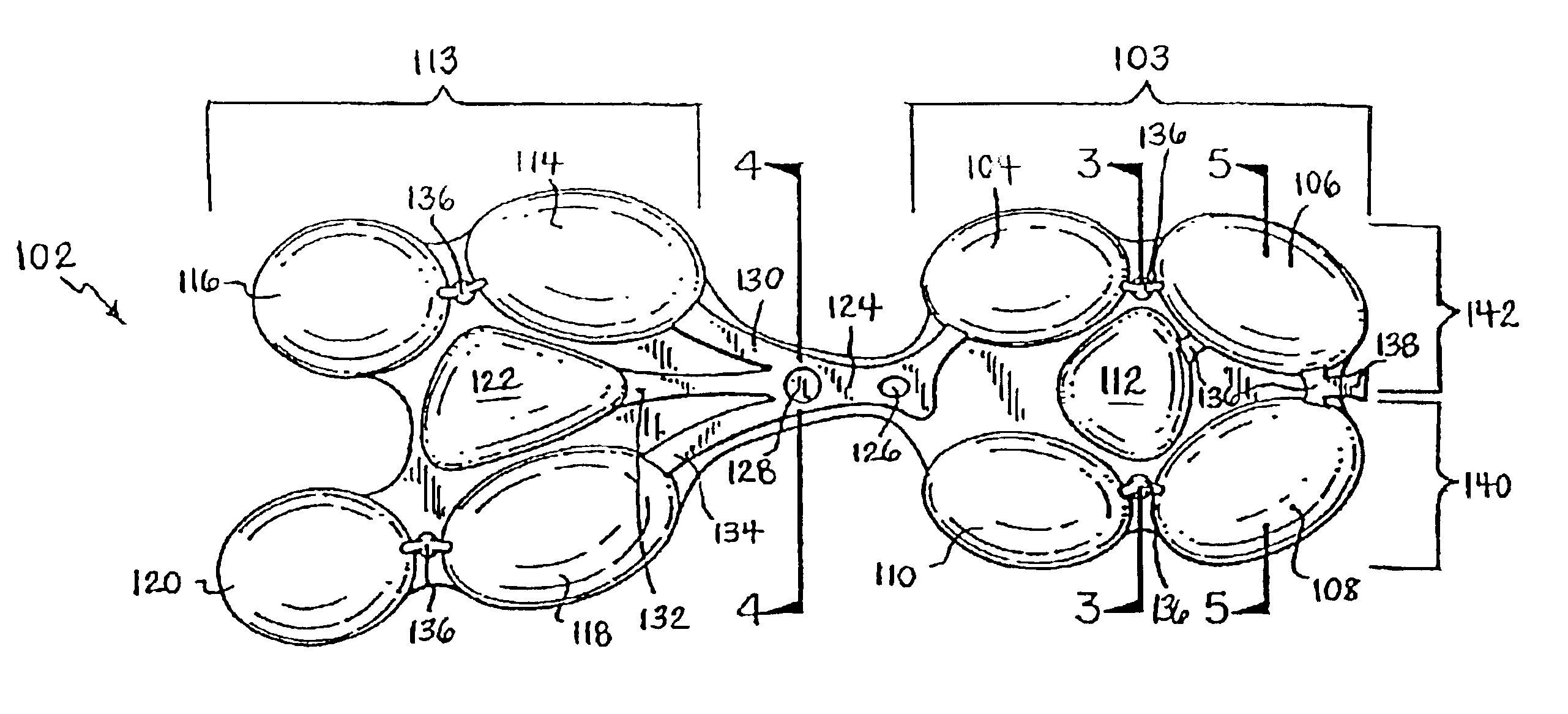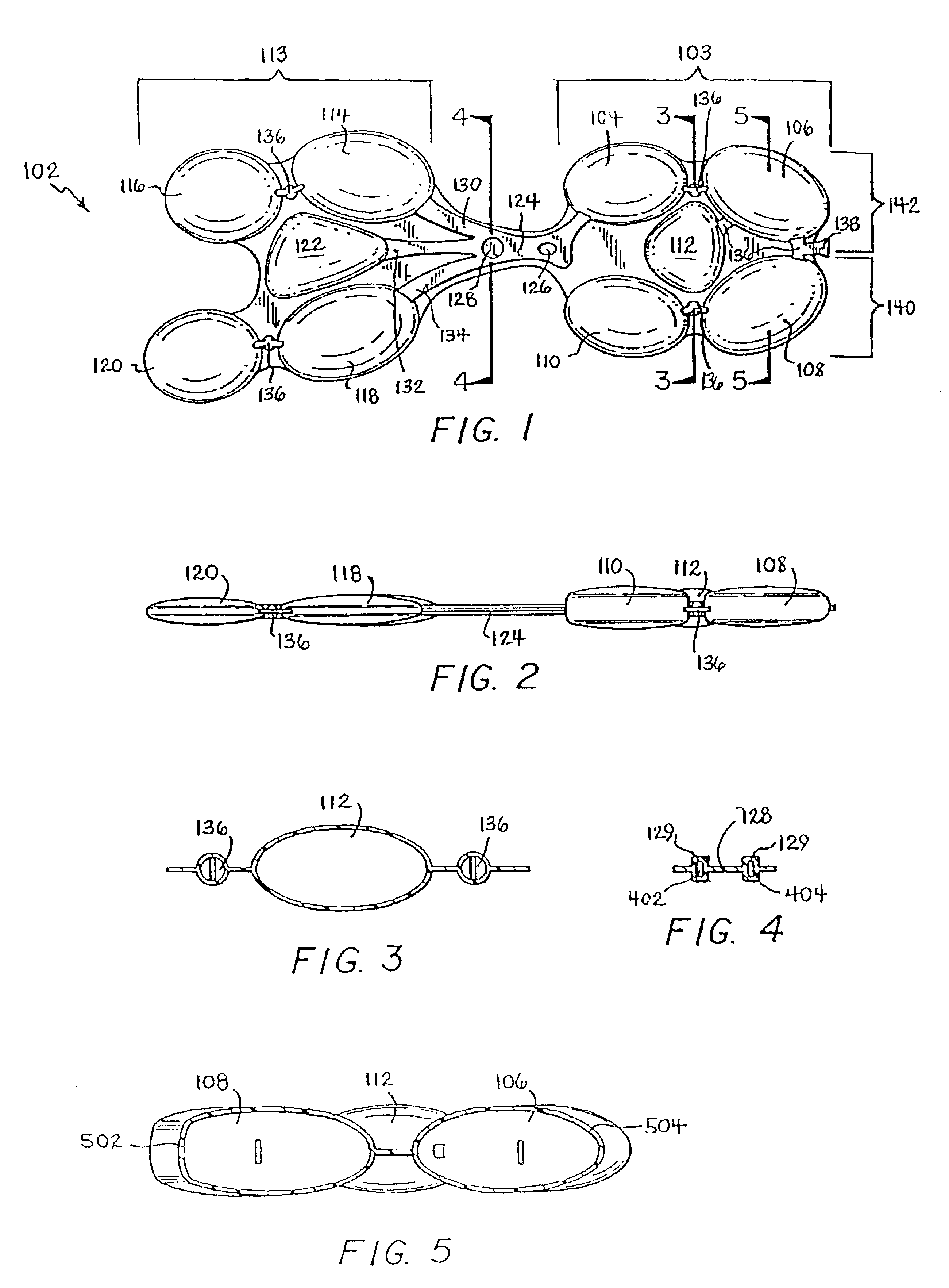Support and cushioning system for an article of footwear
a technology of supporting and cushioning system and footwear, which is applied in the field of footwear, can solve the problems of pain, fatigue, injury, and the inability of the foot alone to effectively overcome many forces encountered during athletic activity, and achieve the effect of reducing discomfort for the wearer, reducing pain, and improving comfor
- Summary
- Abstract
- Description
- Claims
- Application Information
AI Technical Summary
Benefits of technology
Problems solved by technology
Method used
Image
Examples
second embodiment
FIG. 16 shows a bladder 1602 of the present invention. Bladder 1602 has a rear chamber 1604, a first front chamber 1606 and a second front chamber 1608. First and second front chambers 1606 and 1608 are connected via small passages 1610 formed by weld lines 1616. Bladder 1602 has connecting passages 1612 and 1614 formed by weld lines 1616, identical to bladder 1002. Connecting passages 1612 and 1614 connect rear chamber 1604 and first front chamber 1606.
third embodiment
FIG. 17 shows a bladder 1702 of the present invention. Bladder 1702 has a rear chamber 1704 and a plurality of front chambers 1706, 1708, 1710, 1712, 1714 and 1716. Front chamber 1706 and 1716 are connected via a small passage 1718. Similarly, front chambers 1708 and 1714 are connected via a small passage 1720 and front chambers 1710 and 1712 are connected via a small passage 1722. Bladder 1702 has connecting passages 1724, 1726 and 1728. Connecting passage 1724 connects rear chamber 1704 and front chamber 1706. Similarly, connecting passage 1726 connects rear chamber 1704 and front chamber 1708, and connecting passage 1728 connects rear chamber 1704 and front chamber 1710.
fourth embodiment
FIG. 18 shows a bladder 1802 of the present invention. Bladder 1802 has a rear chamber 1804 and a plurality of front chambers 1806, 1808 and 1810. Bladder 1802 has connecting passages 1812, 1814 and 1816. Connecting passage 1812 connects rear chamber 1804 and front chamber 1806. Similarly, connecting passage 1814 connects rear chamber 1804 and front chamber 1808, and connecting passage 1816 connects rear chamber 1804 and front chamber 1810.
With reference to FIGS. 1 and 5, it will be appreciated that resilient insert 102 comprises an insert which may be positioned within different areas of an article of footwear. Accordingly, although resilient insert 102 is shown as being positioned between outsole 604 and midsole 606 in FIG. 6, it is to be understood that resilient insert 102 may also be positioned within a cavity formed within a midsole or between a midsole and an insole Mien positioned between a midsole and an outsole, resilient insert 102 may be visible from the exterior of the ...
PUM
 Login to View More
Login to View More Abstract
Description
Claims
Application Information
 Login to View More
Login to View More - R&D
- Intellectual Property
- Life Sciences
- Materials
- Tech Scout
- Unparalleled Data Quality
- Higher Quality Content
- 60% Fewer Hallucinations
Browse by: Latest US Patents, China's latest patents, Technical Efficacy Thesaurus, Application Domain, Technology Topic, Popular Technical Reports.
© 2025 PatSnap. All rights reserved.Legal|Privacy policy|Modern Slavery Act Transparency Statement|Sitemap|About US| Contact US: help@patsnap.com



